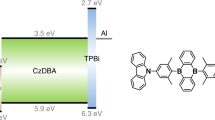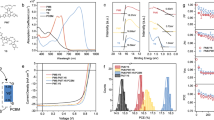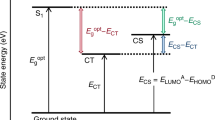Abstract
There has been an active search for cost-effective photovoltaic devices since the development of the first solar cells in the 1950s (refs 1–3). In conventional solid-state solar cells, electron–hole pairs are created by light absorption in a semiconductor, with charge separation and collection accomplished under the influence of electric fields within the semiconductor. Here we report a multilayer photovoltaic device structure in which photon absorption instead occurs in photoreceptors deposited on the surface of an ultrathin metal–semiconductor junction Schottky diode. Photoexcited electrons are transferred to the metal and travel ballistically to—and over—the Schottky barrier, so providing the photocurrent output. Low-energy (∼1 eV) electrons have surprisingly long ballistic path lengths in noble metals4,5, allowing a large fraction of the electrons to be collected. Unlike conventional cells, the semiconductor in this device serves only for majority charge transport and separation. Devices fabricated using a fluorescein photoreceptor on an Au/TiO2/Ti multilayer structure had typical open-circuit photovoltages of 600–800 mV and short-circuit photocurrents of 10–18 µA cm-2 under 100 mW cm-2 visible band illumination: the internal quantum efficiency (electrons measured per photon absorbed) was 10 per cent. This alternative approach to photovoltaic energy conversion might provide the basis for durable low-cost solar cells using a variety of materials.
This is a preview of subscription content, access via your institution
Access options
Subscribe to this journal
Receive 51 print issues and online access
$199.00 per year
only $3.90 per issue
Buy this article
- Purchase on Springer Link
- Instant access to full article PDF
Prices may be subject to local taxes which are calculated during checkout



Similar content being viewed by others
References
Chapin, D. M., Fuller, C. S. & Pearson, G. L. A new silicon p-n junction photocell for converting solar radiation into electrical power. J. Appl. Phys. 25, 676–677 (1954)
Archer, M. D. & Hill, R. (eds) Clean Electricity from Photovoltaics (Series on Photoconversion of Solar Energy, Vol. 1, Imperial College Press, London, 2001)
Goetzberger, A. & Hebling, C. Photovoltaic materials, past, present, future. Sol. Energy Mater. Sol. Cells 62, 1–19 (2000)
Seah, M. P. & Dench, W. A. Quantitative electron spectroscopy of surfaces: a standard data base for electron inelastic mean free paths in solids. Surf. Interf. Anal. 1, 2–11 (1979)
Frese, K. W. & Chen, C. Theoretical models of hot carrier effects at metal-semiconductor electrodes. J. Electrochem. Soc. 139, 3234–3249 (1992)
Grätzel, M. Photoelectrochemical cells. Nature 414, 338–344 (2001)
Green, M. A., Emery, K., King, D. L., Igari, S. & Warta, W. Solar cell efficiency tables (version 17). Prog. Photovolt. Res. Applic. 9, 49–56 (2001)
Sze, S. M. Physics of Semiconductor Devices 2nd edn, Ch. 14 (Wiley & Sons, New York, 1981)
Nienhaus, H. et al. Electron-hole pair creation at Ag and Cu surfaces by adsorption of atomic hydrogen and deuterium. Phys. Rev. Lett. 82, 446–448 (1999)
Acknowledgements
We thank M. White, A. Tavakkoly, A. Kochhar, N. Shigeoka, G. Stucky and W. Siripala for technical assistance and discussions. The project was supported by Adrena Inc. Financial support for J.T. was provided by the NSF-MRSEC funded Materials Research Laboratory (UCSB).
Author information
Authors and Affiliations
Corresponding author
Ethics declarations
Competing interests
E.W.M. is a minority shareholder in Adrena Inc but receives no compensation from Adrena and is not an employee, officer, or manager of Adrena.
Rights and permissions
About this article
Cite this article
McFarland, E., Tang, J. A photovoltaic device structure based on internal electron emission. Nature 421, 616–618 (2003). https://doi.org/10.1038/nature01316
Received:
Accepted:
Issue Date:
DOI: https://doi.org/10.1038/nature01316
This article is cited by
-
Plasmonic phenomena in molecular junctions: principles and applications
Nature Reviews Chemistry (2022)
-
Plasmonic ternary hybrid photocatalyst based on polymeric g-C3N4 towards visible light hydrogen generation
Scientific Reports (2020)
-
Interplay of hot electrons from localized and propagating plasmons
Nature Communications (2017)
-
Strategies for Hot Electron-Mediated Catalytic Reactions: Catalytronics
Catalysis Letters (2017)
-
Polyvinylpyrrolidone-induced anisotropic growth of gold nanoprisms in plasmon-driven synthesis
Nature Materials (2016)
Comments
By submitting a comment you agree to abide by our Terms and Community Guidelines. If you find something abusive or that does not comply with our terms or guidelines please flag it as inappropriate.



